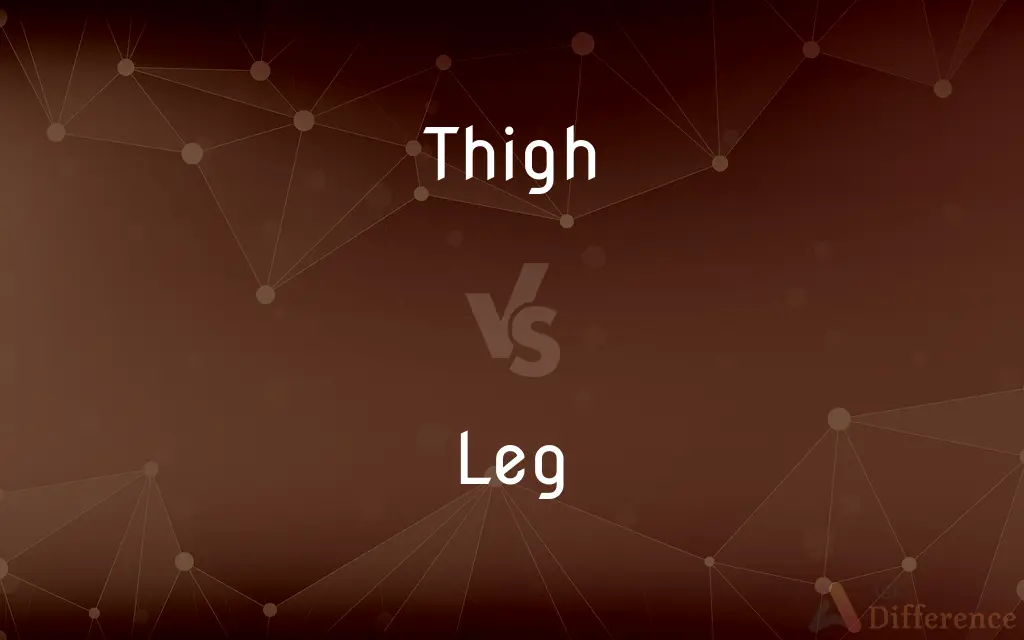Thigh vs. Leg — What's the Difference?
By Maham Liaqat & Urooj Arif — Updated on February 26, 2024
The thigh is the upper part of the leg, while the leg includes both the thigh and lower sections down to the foot.

Difference Between Thigh and Leg
Table of Contents
ADVERTISEMENT
Key Differences
The thigh is a specific part of the human body located above the knee. It contains the femur, the longest bone in the body, and is primarily composed of large muscles like the quadriceps and hamstrings. The leg, in a broader anatomical context, encompasses the entire lower limb from the joint to the foot. It includes the thigh, knee, calf, and foot.
The thigh's function is crucial for movements such as walking, running, and jumping, providing strength and stability. The term "leg" is often used in everyday language to refer to the whole lower limb, but in medical and anatomical terms, it describes the structure involved in locomotion and support of the human body.
The thigh is known for its muscular composition and is a common focus for strength and conditioning exercises, the lower part of the leg (below the knee) includes the calf muscles, which play a vital role in movements like pushing off the ground and maintaining balance.
The distinction between the thigh and the leg is important in various contexts, including medical diagnoses, sports science, and physical therapy. Understanding the specific anatomy and functions of the thigh versus the entire leg can aid in targeted treatments and training regimens.
Thigh is more prone to muscle strains or contusions due to its muscular nature, while the leg can suffer from a wider range of issues, including fractures, shin splints, and knee problems, reflecting the complexity and varied functions of the lower limb.
ADVERTISEMENT
Comparison Chart
Part of Body
Upper section of the leg, above the knee
Entire lower limb, above body to foot
Main Bones
Femur
Femur, tibia, fibula, and bones of the foot
Muscle Groups
Quadriceps, hamstrings
Quadriceps, hamstrings, calf muscles, among others
Function
Major role in walking, running, stability
Support, locomotion, and balance
Common Injuries
Muscle strains, contusions
Fractures, shin splints, knee issues
Compare with Definitions
Thigh
Essential for walking and running.
Her strong thighs helped her excel in track and field.
Leg
Fundamental for movement.
Her legs were strong, supporting her long-distance running ambitions.
Thigh
Home to the body's longest bone.
A fracture in the thigh typically involves the femur.
Leg
Includes thigh, knee, calf, and foot.
Leg injuries can range from simple sprains to complex fractures.
Thigh
Dominated by quadriceps and hamstrings.
Squats are effective for strengthening the thigh muscles.
Leg
Features a variety of muscle groups.
Building leg muscle requires a diverse range of exercises.
Thigh
Susceptible to strains and contusions.
He applied ice to his thigh to reduce the swelling from the contusion.
Leg
Prone to fractures, shin splints, and more.
The soccer player's leg was put in a cast to heal the fracture.
Thigh
The area above the knee.
The athlete suffered a muscle strain in his thigh during the race.
Leg
From upper body to foot.
The massage therapist focused on the entire leg to relieve muscle tension.
Thigh
In human anatomy, the thigh is the area above the knee. Anatomically, it is part of the lower limb. The single bone in the thigh is called the femur.
Leg
A leg is a weight-bearing and locomotive anatomical structure, usually having a columnar shape. During locomotion, legs function as "extensible struts".
Thigh
The portion of the human leg above the knee.
Leg
Each of the limbs on which a person or animal walks and stands
He was off as fast as his legs would carry him
Adams broke his leg
A leg injury
Leg
A limb or appendage that an animal uses for support or locomotion on land.
Insects have six legs.
Leg
In humans, the lower limb extending from the groin to the ankle.
Dan won't be able to come to the party, since he broke his leg last week and is now on crutches.
Common Curiosities
Are leg injuries more complicated than thigh injuries?
Leg injuries can be more varied and complex due to the leg's structure, which includes bones, muscles, and joints down to the foot.
What distinguishes the thigh from the rest of the leg?
The thigh is the upper part of the leg, specifically above the knee, characterized by its muscular build and containing the femur.
What role do the calf muscles play in leg function?
Calf muscles are essential for movements such as pushing off the ground, walking, running, and maintaining balance.
How can thigh strength benefit overall leg health?
Strong thigh muscles can support the knee joint, reduce the risk of injuries, and improve the leg's overall function in daily and athletic activities.
Can improving thigh muscle tone improve leg appearance?
Yes, strengthening thigh muscles can improve the leg's overall appearance by adding tone and shape.
How can one prevent thigh and leg injuries?
Prevention includes regular exercise, proper stretching, strength training, and wearing appropriate footwear for activities.
Can the term "leg" refer to just the lower part below the knee?
In common usage, "leg" might be loosely used to refer to the lower part, but anatomically, it includes the whole lower limb.
How are leg injuries treated differently from thigh injuries?
Treatment can vary significantly; thigh injuries often focus on muscle recovery, while leg injuries may require broader approaches, including bone, joint, and muscle rehabilitation.
Is the femur part of the leg or just the thigh?
The femur is part of the thigh and is the longest bone in both the thigh and the entire human body.
What is the best exercise for strengthening the thigh and leg?
Exercises like squats, lunges, and leg presses are effective for strengthening both the thigh and other parts of the leg.
Why is the thigh important in physical activities?
The thigh's muscles, such as the quadriceps and hamstrings, are crucial for movements like walking, running, and jumping, providing power and stability.
Are there any specific signs of a serious thigh or leg injury?
Signs of serious injury include severe pain, swelling, inability to move the limb, or visible deformity, requiring immediate medical attention.
What is the significance of the knee in separating the thigh from the lower leg?
The knee acts as a pivotal joint that connects the thigh's femur with the lower leg's tibia and fibula, enabling flexion and extension movements.
Why might someone experience more pain in the thigh than in the lower leg?
Pain in the thigh could be due to muscle strains or contusions, which are common in the thigh's large muscular area.
How does the structure of the leg facilitate human movement?
The leg's structure, including its bones, muscles, and joints, is designed to support the body's weight, provide stability, and allow for a wide range of movements.
Share Your Discovery

Previous Comparison
Ostrich vs. Nandu
Next Comparison
Chronicle vs. HistoryAuthor Spotlight
Written by
Maham LiaqatCo-written by
Urooj ArifUrooj is a skilled content writer at Ask Difference, known for her exceptional ability to simplify complex topics into engaging and informative content. With a passion for research and a flair for clear, concise writing, she consistently delivers articles that resonate with our diverse audience.
















































